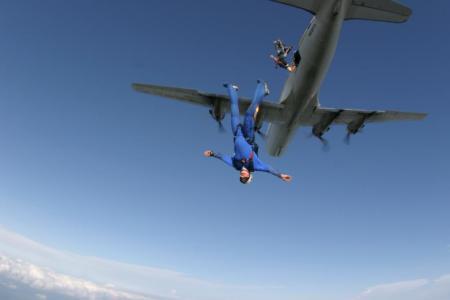Mr.Nuke 0
QuoteYeah, that's another thing that amazes me. Jumpers here have given examples where ATC folk could count the jumpers exiting a plane with their radar.
If the ATC folks had been on the ball or told "look now" they would have been able to see Cooper bail? I mean we were joking about SAGE picking him up. But here he's just 10 miles out from PDX ATC? Should have been easy? (if they were looking)
The problem is PDX likely wasn't looking. Keep in mind 305 wasn't the only flight in the radar operators sector that night (I'm fairly certain It would've been receiving priority though). Also remember that 305 was given instructions to squawk a special transponder code when Cooper jumped. This certainly would have received the controller's attention. Of course that code never came, and no one was certain that a jump occurred until the plane landed in Reno minus a passenger.
QuoteJust understand (as for the rest of you) if i am not responsive it is because I am away on other matters.
All,
Sometimes I get
The guy in the article who rammed the SUV was Ckret. The attached photo shows Ckret in the background (on the cell phone).
So, Ckret…. Why does it take you so long to reply to my e-mails and posts?
Sluggo_Monster
Web Page
Blog
NORJAK Forum
snowmman 3
http://www.ancilnance.com/adams/index.htm
one? tie clip in the pics. seem? to be the rectangular ones that I've been saying I thought were more common.
A briefcase (fattish).
just background for the era/area.
Note younger males may have been transitioning to the "louder", wider ties.
p.s. Dexedrine was being used then as an antidepressant. Maybe Cooper had a medical prescription. (Thora-dex used then for anxiety plus depression)
Quote"After a while, Scott noticed that the cabin gauges were fluctuating wildly."
Gauges? I think only one gauge would have been fluctuating: the cabin pressure gauge which is only on the flight engineer's panel as I recall. His eardrums would have felt it too and probably clued him way before reading any gauges.
377,
You're getting better at this. Ready for your 727 check-ride?
Here's a quote from a systems manual:
Pneumatic Control System
It is a little long in the tooth now, but it is still around and in use on a great
number of aircraft, mostly 100's. Affectionately know as "steam driven". There
are two control panels, again at the flight engineers panel. One for automatic
control and one for manual mode. You set these by markings on the
instrument and it is then entirely controlled by sensed pressures and venturi's.
It's basic, but robust, though pressure bumps are quite a common feature of
this system.
Sluggoi_Monster
Web Page
Blog
NORJAK Forum
QuoteI wonder what "very near" means.
Web Page
Blog
NORJAK Forum
377 22
Unlike SAGE which had massive processing (which ironically would have blocked out any echos very close to a tracked trasnponder equipped acft), normal ATC radar likely would have shown Cooper's exit, especially at a range of ten miles or so.
Even if the exit echo wasn't noticed in real time, it could be viewed on a replay.
377
QuoteGotta take into account the Captain as lord god of the airliner aspect. Respected, in charge, gives orders, doesn't take them from anyone in his plane... that is until Cooper comes aboard. Took many years to earn those stripes and now some jerk acts like he is a bus driver. Might not be real eager to relive those hours when someone else was in command of HIS plane.
That was especially true prior to “Cockpit Resource Management” (CRM) training, which began in the late 1980s.
In the 1960s, I had an uncle who was a low employee number Delta Pilot, I was amazed that his crew feared and respected him so much. To me he was a pussy-cat, to them he was Captain Kid.
Sluggo_Monster
Web Page
Blog
NORJAK Forum
QuoteQuoteThe new LZ is just 10 miles from PDX.
REPLY & QUESTION>
See the 72 FBI LZ maps attached. Note the wind
vector lines A-B, H-P, O-R which define drift at the
various latitudes. Arent they going the wrong direction
vs the wind charts you found? It should be SE to NW,
not SW - NE as shown on the 72 maps ???
What am I missing!?
BTW I did a little gamma adjustment on this map
so its a bit easier to read - more B&W contrast.
George
Warning:
Danger Will Robinson… Danger Danger
Do not confuse “winds aloft” with ground level winds. If navigators and pilots did that, they would be in a world of hurt.
Want to know what the prevalent winds at ground level are? Find the nearest airport and look at the runway alignment(s).
Sluggo_Monster
Sorry about the Will Robinson quote, I don’t watch movies like you guys do. What was the “big toe” reference?
Web Page
Blog
NORJAK Forum
377 22
QuoteQuoteJust understand (as for the rest of you) if i am not responsive it is because I am away on other matters.
All,
Sometimes I getfuriousangryfrustratedirritated with Ckret, especially when he doesn’t reply to my posts, IMs, or e-mails in a timely manner. Today I ran across THIS and it reminded me that our favorite Special Agent has a “real-job” and isn’t setting around the office reading dropzone.com posts and answering e-mails.
The guy in the article who rammed the SUV was Ckret. The attached photo shows Ckret in the background (on the cell phone).
So, Ckret…. Why does it take you so long to reply to my e-mails and posts?
Sluggo_Monster
Damn, if I ever turn from highway robbery to bank robbery I am going to carefully avoid Ckret's district. I don't want to run into James Bond while I am trying to get away.
I remember a bar in SF that was frequented by Samoans, Tongans and other BIG HUGE guys. An SF cop told me that when they got a call about a fight there, they would wait about ten minutes and then roll. "No need for me to get between two crazed elephants when I am only four years from retirement" is how one cop described it. "We kinda let them work things out on their own before we show up."
Different response philosophies.
377
377 22
QuoteQuote"After a while, Scott noticed that the cabin gauges were fluctuating wildly."
Gauges? I think only one gauge would have been fluctuating: the cabin pressure gauge which is only on the flight engineer's panel as I recall. His eardrums would have felt it too and probably clued him way before reading any gauges.
377,
You're getting better at this. Ready for your 727 check-ride?
Here's a quote from a systems manual:
Pneumatic Control System
It is a little long in the tooth now, but it is still around and in use on a great
number of aircraft, mostly 100's. Affectionately know as "steam driven". There
are two control panels, again at the flight engineers panel. One for automatic
control and one for manual mode. You set these by markings on the
instrument and it is then entirely controlled by sensed pressures and venturi's.
It's basic, but robust, though pressure bumps are quite a common feature of
this system.
Sluggoi_Monster
Ready for my 727 FE check ride Sluggo. Very few 727s still flying passengers anywhere and the 727 freighters are dwindling due to high fuel burn and 3 person cockpit .
Maybe I could get a job with Donald Trump. He has two 727s. They burn fuel like mad but they are considerably faster than most of the more modern and economical jets in that weight class. Time is money.
Get ready for a return of the extinct Boeing 377 Stratocruiser. Famed aviator Clay Lacy is building one out of a couple of surplus KC 97s. It will probably reside in Ckrets territory at the museum at Boeing Field.
Can you imagine the fuel bill for a plane that has four 28 cylinder 4360 cu inch gasoline engines???
377
Quote
QuoteQuoteQuote
But now that I'm reading it, and confirming sections of it with things Ckret has said, I think it potentially has some interesting details that we could discuss. I was amazed when Ckret released the memo confirming the flaps were changed to 30 degrees. Tosaw says this also. Tosaw says that when the flaps were at 30, the speed went from 170 knots to 145 knots (167mph)
Flaps 30 or 40 on most planes requires near landing speeds. In fact, I pulled out my 737 reference charts and for both 30 and 40 instead of giving a specific knot number it simply says Final Approach Speed. There likely would be a slowdown associated with lowering the flaps.
Thanks Nuke (I always think of you as The Cooler for some reason :)
What flabbergasts me, is that this 30 degree flap/slowdown issue was in the FBI summary report for 37 years. And so it's clear that Cooper jumped at a reasonable exit speed right? And the story's been put in the papers forever that he jumped at some crazy speed. I mean, the more we learn, I'm expecting the jumpers out there to be thinking: easier and easier jump?
It depends on what you consider reasonable exit speed and clear. I'm looking at files that accompany accompany a payware 727 plane for a flight simulator. I'm not sure how accurate they are, but they have the maximum extension speed for 30 degrees as 180 knots. Other than Towsaw there is nothing to confirm the drop to 145 knots.
All,
I’m not a 727-Jockey but I do
Attached is a generalized “Visual Approach to Landing” chart (as opposed to an Instrument landing (ILS)). The actual values would be Model (100/200) and aircraft weight dependent but it gives a rough idea of “Approach-to-Landing” speeds vs. flap settings.
From this image I get:
Flaps at 2º = 190 kts
Flaps at 5º = 160 kts
Flaps at 15º = 150 kts
Flaps at 25º = 140 kts (with gear down)
Flaps at 30º = No Vref
Flaps at 40º = No Vref
Points to Ponder:
Transcript Page 100 - Flying instructions given to Flt 305: “…any flap position between 5 and 40 down to 120 kts” [Note: Vref for 40º flaps must have been 120 kts.}
Transcript Page 103 – Flt 305 reports conditions: “… holding at 7 thousand feet, 160 kts which is 5 kts above the bug (5 kts above Vref)”. [Note: This leads me to believe the flaps were at 15º at that point.]
Remember:
Actual flight parameters were determined by the Airline’s Pilot Operating Proceedures, and may vary considerably from the attached chart (and above text).
Oh yeah! Just to protect myself from bottom-feeding lawyers (close your ears 377, you aren’t one of them):
The above information is for discussion and instructional purposes only. DO NOT USE FOR ACTUAL FLIGHT NAVIGATION!
Web Page
Blog
NORJAK Forum
In a previous post I referenced Vref as “stall speed” and “the Bug” as Vref or stall speed. The bug is Vref but not stall speed.
It is more likely that the page 103 reference to “the bug” was Stall speed (Vso) x 1.3 (or some other number discussed below).
So the aircraft may have been in at Flaps = 30º at that point.
The bug setting is done in modern times by a Flight Management Computer (FMC). The flight management computer, by way of reverse electronic osmosis (or by just being plain smart) knows the weight of the plane, and provides Vref calculations based on the ambient conditions and the weight it measures.
In 1971 the calculation may have been manual, but the result is the same.
I have learned more than I ever wanted to know about Flap Settings on B-727s in the last hour.
Sluggo_Monster (waiting for a “nickname”)
Web Page
Blog
NORJAK Forum
snowmman 3
This is good info from Tosaw's book (page 36).
I think it shows how the re-enacted pressure bump was erroneously correlated to the reported oscillations on the radio.
It's convincing (to me) information about how errors were apparently made leading to a focus on Lake Merwin. I suspect Lake Merwin area was identified even before the plane landed at Reno.
From Tosaw (written in '84)
"Soderlind in Minneapolis had been monitoring the plane's radio and heard the crew's reaction to the 8:13 pressure bump. He immediately began to determine the plane's position at that time. In a few minutes he was able to draw an area on a map into which he believed Cooper had landed. The area was rather large because of his not knowing exactly where the plane was on the Victor-23 line at 8:13 and because of the varying forces and directions of the wind. The wind was blowing from the southwest so Soderlind used the Victor-23 line as the western boundary of Cooper's landing zone and allowed several miles for drift after he left the plane.
The northern boundary of the probable landing zone started at Woodland, Washington, and extended south about 20 miles to Portland, Oregon on the Columbia River."
Before this, on page 35, Tosaw says something that I think was based on erroneous information from the people he interviewed. (Tosaw did his work in '83 roughly? book published in '84)
"Suddenly, at 8:13, the four crew members in the cockpit felt a burst of pressure in their ears. "There he goes," shouted Rataczak, and they all saw the needles reacting on the pressure gauges. They looked out of the cockpit windows, but it was too dark to see anything. Tina began buzzing Cooper on the interphone but did not receive an answer. She tried to raise him on the public-address system but heard nothing"
Says flaps were put back to 15 and the speed went back up to 195mph. But it's not clear exactly when that happened.
What's interesting is that the predicted area was initially Woodland to Portland, but it got crushed down to the Woodland area erroneously. If they would have stayed with the idea that Woodland to Portland was equally likely, things might have been better.
Oh, on page 38, it does say when they got to Reno:
"Captain Scott relieved Rataczak at the controls and the plane began its descent into the Reno airport"
So maybe we should correct our facts/myth to say that Scott landed the plane.
377 22
QuoteTranscript Page 103 – Flt 305 reports conditions: “… holding at 7 thousand feet, 160 kts which is 5 kts above the bug (5 kts above Vref)”. [Note: This leads me to believe the flaps were at 15º at that point.]
In any event, it was likely a high speed exit as sport jumping goes, but not a brutally mauling high speed. The 727 sans all the other passengers was flying light. That would give lower stall speeds thus allow slower flight for a given flap setting in comparison to a fully loaded plane.
377
snowmman 3
page 34
"The plane was still climbing as Tina walked toward the cockpit; she came to the curtain that separated the two sections and looked back at Cooper standing by the open door. [ed. aft door] He waved goodbye as he raised his hand in a farewell salute. She closed the curtain and snapped of the cabin lights"
So the lights were on until Tina entered the cockpit. This salute thing is interesting. Minimally, Cooper seemed relaxed at the impending jump.
"Tina entered the cockpit and the crew was happy to see her, although she looked fatigued.
...
When Tina sat down on the observer's seat she told them that Cooper had already walked down into the stairwell. Tina also told the crew that Cooper had the briefcase with the bomb nearby and said he was going to disarm it or take it with him.
Then at 7:45 p.m, about five minutes after Tina entered the cockpit the interphone buzzed. They heard Cooper's void over the din of the engines.: "Slow down a little; I can't get the staircase down."
Tina communicated with the cockpit with the interphone? So Cooper may have known how to do this just by watching Tina previously?




It depends on what you consider reasonable exit speed and clear. I'm looking at files that accompany accompany a payware 727 plane for a flight simulator. I'm not sure how accurate they are, but they have the maximum extension speed for 30 degrees as 180 knots. Other than Towsaw there is nothing to confirm the drop to 145 knots.
Share this post
Link to post
Share on other sites